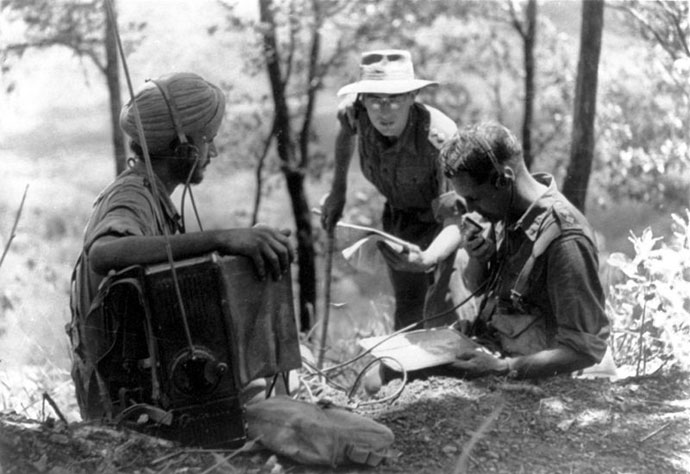2014 – The 70th Anniversary year of the Battle of Imphal
Hemant Singh Katoch *

On Imphal front, Sikh signaller operates wireless for British officers, listening to patrols reporting Japanese positions :: Pix - wikipedia
2014 is the 70th Anniversary year of the Battle of Imphal. At this time seven decades ago, some 200,000 Japanese, Britons, Indians, Gurkhas, and men from several other nationalities were preparing themselves to face off in Manipur. From March to July of 1944, they clashed in the hills and valley in what is now seen as one of the greatest battles of the Second World War.
The word 'greatest' has not been used here carelessly. If you care to look, there are many similar quotes and descriptions that underline the importance of what happened in Manipur in 1944. For example, in an essay in History Todayin 1995, the American author Peter Heehswrites, "Imphal was one of the greatest Allied victories of the war".
In their book Imphal, Geoffrey Evans and Antony Brett-James describe Imphal as "the greatest defeat on land ever suffered by the Japanese in the course of their history." And if any further confirmation of its import was needed, the combined Battle of Imphal/Kohima was in 2013 named 'Britain's Greatest Battle' by the UK's National Army Museum.
So what then should Manipur make of 2014, the 70th Anniversary year of the Battle of Imphal? Simply put, it should see this year as a terrific opportunity for itself on many counts. For one, it should use the 70th Anniversary to generate interest among audiences in the country and abroad in its Second World War experience, epitomised by the Battle of Imphal (but by no means limited to it).The designation in 2013 as 'Britain's Greatest Battle' should help make this a much easier task than before.
Second, the 70th Anniversary should be used as a platform to boost battlefield tourism in Manipur. This needs to move beyond what currently passes for battlefield or remembrance tourism in the state: perfunctory visits to the two Second World War cemeteries in Imphal or the Japanese War Memorial / India Peace Memorial in Maibam or the INA Memorial Complex in Moirang.
This is not nearly enough as it completely leaves out of the picturepeaks (such as Laimaton, Nungshigum), villages (such as Shangshak, Ningthoukhong), and even airfields (such as Koirengei, Kakching) around Manipur which are directly linked to the events of 1944. Ways must be found to weave these into the narrative of the Battle of Imphal and the Second World War for any visitor.
Third, and closely related to the previous point, Manipur shouldresolve from 2014 onwards to take much greater care of its Second World War attractions and heritage. This could include a range of measures, such as ensuring the cleanliness of the surroundings of existing sites, with the two Second World War cemeteries in Imphal being an easy example.
Equally, and perhaps much more importantly, steps should be taken to secure and preserve any trenches, bunkers, dugouts and other reminders of the War that continue to be discovered across Manipur to this day. These are sites of immeasurable value which help us understand and imagine the fighting and conditions during the War as perhaps no spoken word can.
Fourth, the year 2014 should be used as an opportunity to better educate and inform Manipur's own people about what happened here during the War – and of its importance to Manipur itself. A perfect place to start would be with school children, many of whom spend hours learning about what happened during the War in Europe and elsewhere, but tragically have little idea of events in their own backyard.
As an aside, for interested adults, one would recommend reading – if you can get your hands on it – an excellent 30-odd page booklet written by Prof. N. Lokendra, the current Registrar of Manipur University, and brought out by the Manipur State Archives in November 1993. Titled "Manipur during World War II (1941-45) – Socioeconomic Change and Local Responses", this brief document is a treasure trove of meticulously researched material on the impact of the War on Manipur.
Fifth, 2014 should be seen as an occasion to learn. The lessons learnt from any events organised to commemorate the 70th Anniversary should be incorporated into future plans, such as marking the 75th Anniversary in particular, and the development of battlefield tourism in Manipur in general. We should also observe how Europe and the West marks the 100th Anniversary of the First World War this year to see how best to make such commemorative events more meaningful for the people of Manipur and external visitors.
To conclude, 2014 as the 70th Anniversary year of the Battle of Imphal is indeed an opportunity for Manipur - to realise, share and promote its Second World War experience with the wider world like never before. Whether this opportunity gets translated into meaningful action or not will depend on the initiative taken by the people and authorities of the state.
* Hemant Singh Katoch wrote this article for The Sangai Express. the writer founded a website in 2012 dedicated to the Battle of Imphal and Manipur's Second World War experience (www.battleofimphal.com). He currently researches, designs and conducts tours around the Battle of Imphal.
This article was posted on January 04, 2014.
* Comments posted by users in this discussion thread and other parts of this site are opinions of the individuals posting them (whose user ID is displayed alongside) and not the views of e-pao.net. We strongly recommend that users exercise responsibility, sensitivity and caution over language while writing your opinions which will be seen and read by other users. Please read a complete Guideline on using comments on this website.







